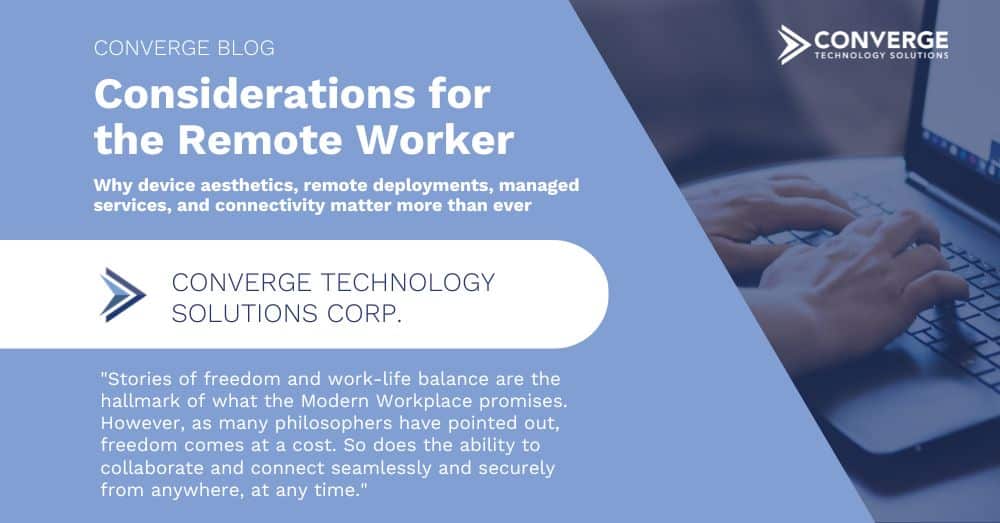Why device aesthetics, remote deployments, managed services, and connectivity matter more than ever.
Imagine waking up at the cottage, making a coffee, grabbing a tablet, sitting on the porch to watch the sun over the water, and logging into work for a few hours. Time spent on things like a stressful commute can now be replaced with a sunrise yoga session or whatever pursuit of your choosing.
Stories of freedom and work-life balance like these are the hallmark of what the Modern Workplace promises. However, as many philosophers have pointed out, freedom comes at a cost. So does the ability to collaborate and connect seamlessly and securely from anywhere, at any time.
While the story above may be relatable to some, the move to a hybrid or remote workplace has not been quite as Zen for many, particularly if it took place during a global crisis.
At the start of the pandemic, as millions of workers across North America began working from home, decision-makers, IT teams, and employees had to contend with issues related to setting up their home office, deploying and managing devices remotely, and dealing with connectivity issues.
Let’s explore some of these employee-centered considerations and a few mitigation strategies for a smooth transition to a Modern Workplace.
The “Home Office” and Device Aesthetics
First and foremost, for many, setting up a fully functioning workspace at home has not been an easy feat. Things previously taken for granted, like printers and scanners, were suddenly not as readily accessible. And many do not have the space in their home to put a desk and a chair.
In a survey conducted in October 2020, only 36% of respondents reported having a dedicated workspace in their homes.[i] Furthermore, nearly half said they worked from the kitchen, bedroom, and other areas around the house.
Ensuring employees’ homes are not taken over by cables, plugs, and big clunky devices is now an important consideration. As is limiting light and sound emanating from multiple devices. Suddenly laptops, smartphones, tablets, printers, etc., are no longer just work tools. They have now become part of the home.
According to Microsoft’s Ralf Groene, Creative Director at Surface, the principle of balancing beauty and function is at the core of the brand’s design philosophy. “We are always trying to simulate how someone would feel. Why did it make you feel that way? Is it the materials, the proportions, how you carry it around, how you charge it?”[ii]
Self-reliance for Deployments and Management
In a traditional work environment, when a new employee started or an existing employee moved or upgraded, devices would need to be configured by the IT department and installed in person by an IT team member. Often that was accompanied by a one-on-one tutorial and some pointers for navigating the company infrastructure.
However, in a remote or hybrid environment, some of the responsibility for successful deployments has been passed down to employees with wide-ranging technical abilities. Solutions to these challenges include a combination of ready-to-deploy devices, Zero Touch deployment technology, and managed services. Some OEMs are even building all three elements into each device.
For example, all Microsoft Surface devices are equipped with Autopilot. This allows imaging and enrollment to be done remotely. Equipped with a full suite of productivity applications, like Microsoft Teams, they are ready to use as soon as they are taken out of the box.
Remote deployments are beneficial even if the workforce is not entirely remote. According to some studies, Autopilot reduced the process of configuring devices by an average of 25 minutes per device. Application provisioning time was reduced by 2.6 hours per application request. Device security and customization times were reduced by 2.5 hours per device.[iii]

Coping with Isolation
According to a study on remote work conducted in 2021, 21% of remote workers say that the biggest struggle of working remotely is loneliness. Another 21% said that it was collaborating and communicating.[iv]
The reality is that the office is more than just a place of work for many. It is where lifelong friendships are formed, and high-functioning teams create magic. The ability to recreate the conditions for this virtually is vital to maintaining a thriving and engaged workforce in a remote or hybrid environment.
Applications like Microsoft Teams have, to some extent, filled a big part of this gap. The Teams meeting has replaced the boardroom. Real-time collaboration and communication keep work units moving in harmony. The audio call has replaced the phone call. And the video call has replaced the knock on the office door.
Connectivity
None of these Modern Workplace solutions are possible without workers having access to a stable internet connection. For many households, this is simply not possible.
The Government of Canada has set a target of ensuring that all Canadian homes and businesses have access to broadband Internet speeds of at least 50 Mbps for downloads and 10 Mbps for uploads by 2026.[v]
Currently, over a third of Canadian households fall below bandwidth targets.[vi] More than 50% have access to speeds of less than 5 Mbps in places like Nunavut.
While increasing internet access falls beyond our scope of work, internet access at home is an important consideration when transitioning to a remote or hybrid environment.
This has been less of an issue for our urban clients. However, it is a challenge that we have helped numerous Government and commercial organizations with operations across the country address.
Final Thoughts
Despite the challenges and considerations listed above, the Modern Workplace is here to stay, at least as far as employees are concerned.
According to a survey conducted earlier this year (2022), 97% of remote workers would like to continue working remotely. 56% say they prefer a fully remote environment, and 30% say they would prefer a remote-first environment.[vii]
[i] https://www.commercialcafe.com/blog/survey-people-want-bigger-home-with-office/
[ii]Meet four people who are designing the future of Microsoft
[iii] 5 Zero Touch Deployment (microsoft.com)
[iv]30+ Work From Home Statistics | Remote Work in 2022 (yourbestdigs.com)
[v]https://crtc.gc.ca/eng/internet/performance.htm
[vi]The Daily — Access to the Internet in Canada, 2020 (statcan.gc.ca)





